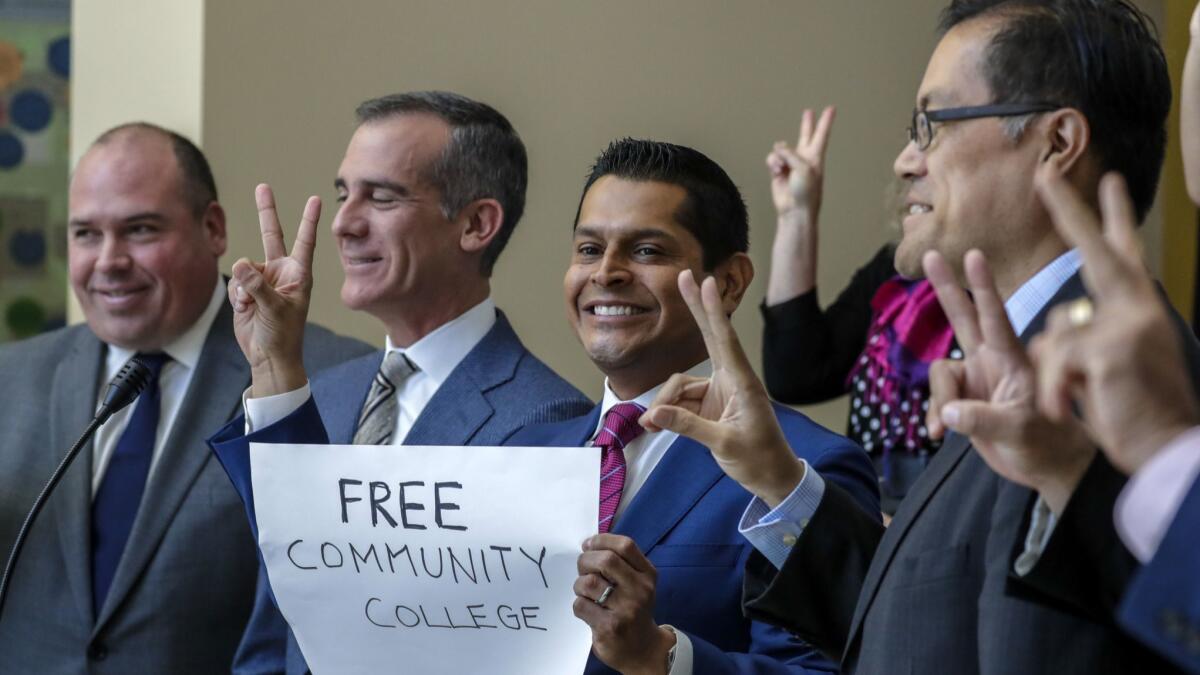Capitol Journal: Spending on free community college for Californians would pay off big for the state

- Share via
Reporting from Sacramento — A little-noticed gem in Gov. Gavin Newsom’s proposed budget would return California partway back to its glory days of tuition-free college.
It’s a relatively tiny, $40-million item in a $209-billion state budget — and a bargain.
It certainly wouldn’t return California all the way back to when my generation — and all those before ours — could go to any public college without paying tuition.
That included what we called “junior college,” “state college” (later fancied up to California State University) and the University of California.
A college away from home, of course, really wasn’t free. There were housing and book costs. But just about any kid who wanted a college degree could afford one in California.
California provided its citizens a tuition-free higher education because it was a sound investment for the state. It helped California achieve greatness by broadening the middle class, offering an opportunity for upward mobility not available in other states and supplying an educated work force for a rapidly expanding economy.
Credit the Republican Party. Back then, Republicans mostly controlled the governor’s office and the Legislature.
When Democrats took over, they started spending on other things and Republicans mostly went along: much more generous welfare, increasingly costly Medi-Cal healthcare for the poor and lots of prisons.
The back-breaker was Proposition 13, which severely reduced property tax revenue for local governments and schools. The state bailed them out, leaving less money for higher education.
Tuition began creeping onto campuses in the 1970s, but didn’t soar until the 1990s. Now it’s $7,300 at CSU and about $14,000 at UC.
There were no course fees at community colleges before 1984. Then the Legislature began tapping students at $5 per unit. Now it’s $46.
“For a lot of people in the upper middle class, $46 doesn’t sound like a lot, but costs of everything keep going up and many families are living paycheck-to-paycheck right now,” California Community College Chancellor Eloy Ortiz Oakley says.
“The cost of attending college in California has significantly increased in the last decade and really put a strain on working-class families. We’re not talking about affluent students in community college.”
A community college degree requires 60 units. To obtain that in two years costs $1,380 in fees annually.
Two years ago, the Legislature took a small but significant step back to the future. It passed a bill allowing first-year, full-time students to attend community college without paying course fees.
Gov. Jerry Brown was leery. Some advisors objected to eliminating fees for students who could afford them. Problem is, there aren’t that many community college students who can pay $690 for 15 units without a hard stretch. The late Nancy McFadden, his top aide, persuaded the governor to loosen up and sign it.
Now, that bill’s author is pushing legislation to provide a second year of free tuition for full-time students.
“This should be a no-brainer,” says Assemblyman Miguel Santiago (D-Los Angeles), who attended community college at Moorpark and is a past board member of the Los Angeles Community College District.
“When students go full-time, they’re more likely to be successful.”
Coverage of California politics »
Community college advocates took the idea to Newsom during his gubernatorial race. He bought it and campaigned on the proposal.
Actually, Santiago and other community college enthusiasts want to expand the bill further. They’d like to provide two years of free courses for all full-time students, whether they’re first-timers at community college or not.
Now, if a student attends part time, drops out for a semester and returns full time, he has lost his freebie eligibility. He’s no longer a first-time student.
Assemblyman Kevin McCarty (D-Sacramento), chairman of the Budget Subcommittee on Education and Finance, says he’s a prime example of why all full-time students should be permitted to go free for two years.
“I flunked out of high school, went to an adult school to get a diploma, then turned to a community college,” McCarty says. “The first year I screwed around and didn’t do too well. Then I went to work. At about age 20, I decided I wanted to go back.
“A lot of community college students take a couple of years to get their act together, like me.”
McCarty finished community college and transferred to Long Beach State.
The assemblyman says it would cost an extra $20 million to extend free tuition to all full-time students for two years. That’s on top of $40 million for the current law plus another $40 million for the new legislation — $100 million total if all full-timers were included. Full time is 12 units.
The L.A. Community College District jumped ahead and began providing tuition-free classes for new full-time students a year before the law took effect.
“It’s working as planned. We’re just thrilled,” says Chancellor Francisco Rodriguez, whose parents were Mexican immigrant factory workers with eight years total schooling between them.
“The power of education to transform a person’s life is why I’m so zealous about this. It’s the key to a better life.”
California has 115 community colleges for 2.1 million students. Half already have their fees waived because they’re poor. Many of the rest are attempting to juggle a couple of courses with a job or two.
Twenty-three other states — red and blue — provide some form of tuition-free community college.
It’s probably the best bang for the buck in Newsom’s budget.
Follow @LATimesSkelton on Twitter
More to Read
Get the L.A. Times Politics newsletter
Deeply reported insights into legislation, politics and policy from Sacramento, Washington and beyond. In your inbox three times per week.
You may occasionally receive promotional content from the Los Angeles Times.











